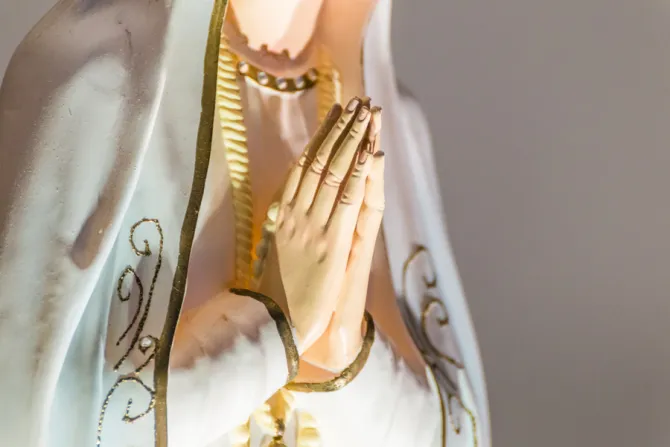Fatima, Portugal, Apr 21, 2017 / 02:02 am
The canonization of Fatima visionaries Francisco and Jacinta Marto has been hailed as an exciting moment for the Church, but the rector of the Marian shrine has said that it bears an even greater significance in terms of putting a spotlight on Our Lady's message.
"I think the canonization in a certain way helps to give credibility to the apparitions and to the message of Fatima," Fr. Carlos Cabecinhas told CNA.
This is an "indirect credibility," he said, but one which nonetheless "makes us look to the protagonists of the events of Fatima and to see their holiness, the holiness with which they challenge us to live this message."
Mary appeared to Francisco, Jacinta and their cousin Lucia May 13, 1917, for the first time, asking them to pray the rosary and make sacrifices for the conversion of sinners, which they did with decisive commitment.
Our Lady continued to appear to them on the 13th of each month until October of that year, making constant appeals for an increase in faith, hope, conversion and prayers for peace. In addition, she also revealed to the children three "secrets," which are now known to be a vision of hell interpreted as scenes from World War II, the rise and fall of Soviet Communism, and what was a foreshadowing of the 1981 assassination attempt on St. John Paul II.
After the apparitions, Francisco and Jacinta Marto died in 1918 after a serious bout of the Spanish flu at 9 and 11, but were known to pray often and offered up daily sacrifices for the conversion of sinners and an increase in love for God.
In this context, Fr. Cabecinhas said he believes the canonization of siblings Francisco and Jacinta "has this value: not only two Saints in the Church, but two Saints who challenge us to look to the message of Fatima and to understand that Fatima is also a school of holiness for each one of us."
Fr. Cabecinhas has been the rector of the Fatima Marian Shrine since 2011, and is in charge of the bulk of preparations for the Pope's May 12-13 visit.
He said the centenary of the apparitions, the canonization and the growing anticipation of Pope Francis' visit "is a moment of great joy" for the people of Portugal, but also for him personally.
"For me it has been a great gift of God to be able to live this moment before the shrine and to have in my hands the decisions of the Shrine. It's a gift of God, but also a great responsibility," he said, explaining that they are in the midst of making final preparations.
In general, preparations are going "very well," he said, noting that all of the big decisions have been made and things are falling into place, so it's down to the final, last-minute work of getting ready to host an estimated 500-800,000 pilgrims during the May celebrations.
Speaking of the reason why pilgrims choose to visit Fatima in particular, the priest said it's "without a doubt" because "they seek a strong experience of God, a strong encounter with God."
"This is specific to Fatima," he said, noting that while other shrines and holy sites are associated with physical healings or other fruits, the people who come to Fatima "come to have a strong experience with God, they come to change their lives, and many times this is the experience they transmit."
"We say that at Fatima there are no physical healings – there are some, but (what is) specific to Fatima is the change of heart, the change of life, orienting one's life toward God," he said, saying that another characteristic unique to Fatima is "silence."
Cabecinhas said that when pilgrims speak to him about their experience visiting the shrine, many of them comment on how silent and prayerful the environment is, which is something he hopes each person who comes is able to experience.
The shrine has also been a popular place for Popes to visit, with Bl. Paul VI being the first pontiff to do so in 1967. St. John Paul II followed suit in 1982, making a trip that was largely intended to pay homage to Our Lady of Fatima, whom he credited with saving his life when he was shot May 13, 1981.
Benedict XVI also visited the Fatima shrine in 2010, continuing the papal tradition of traveling to the holy site, and cementing even further it's link to the Pope.
(Story continues below)
Fr. Cabecinhas said he believes Popes come to Fatima so often is because it has "a universal message, a message for the entire Church," which is something each one of them have understood.
"They have seen that Fatima has something to say to the entire Church on the place of God in the life of the believer, and it's because of this they have come, to highlight this message," he said, adding that he has no doubt that the presence of Popes at the shrine "has helped to then diffuse the message in the entire world."
With an entire year of celebrations extending beyond just the May celebrations, Cabecinhas said he hopes those who come even after Pope Francis' visit get to experience and understand Our Lady's message on a deeper level.
The priest said he wants pilgrims to have "a joyful experience of being at Fatima" and to have "an experience of encounter with God through the Madonna."
"She is presented here as a path toward God and a refuge in our hardship," he said, so "what we want is that each pilgrim who visits this year can have this experience and can say, 'yes, I went to Fatima, and the Madonna for me was a refuge in difficult moments, but a path that guided me to God.'"



